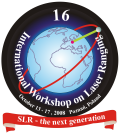PROGRAM
| Monday, October 13 | ||
| 8:00 - 9:00 | On-Site Registration | |
| 9:00 - 10:00 | Welcome/Introduction | |
| 10:00 - 10:30 | Break | |
| Scientific Achievements, Applications and Future Requirements (first session) Zuheir Altamimi, IGN, France Steven Klosko, SGT, USA | ||
| Session Summary | ||
| 10:30 - 10:45 | Laser Ranging Contributions to Earth Rotation Studies Richard Gross | [PPT] |
| 10:45 - 11:00 | Geocenter Motion: Causes and Modeling Approaches Erricos C. Pavlis, Magdalena Kuzmicz-Cieslak | [PDF] |
| 11:00 - 11:15 | International Terrestrial Reference Frame - Latest Developments Horst Mueller | [PPT] |
| 11:15 - 11:30 | Status of ITRF Development and SLR contribution Zuheir Altamimi | [PPT] |
| 11:30 - 11:45 | Determination of the SLR station coordinates and velocities on the basis of laser observations of low satellites P. Lejba, S. Schillak | [PPT] |
| 11:45 - 12:00 | Temporal variations of the Earth gravity field derived from SLR Data over a long period of time Florent Deleflie, Pierre Exertier, Olivier Laurain, Dominique Feraudy, Jean-Michel Lemoine | [PPT] |
| 12:00 - 12:15 | A 33 Year Time History of the Earth Dynamic Oblateness changes from SLR data Minkang Cheng, Byron D. Tapley | [PPT] |
| 12:15 - 12:30 | ICESat, GRACE, and Time Varying Gravity: SLR Contributions and Applications S. B. Luthcke, D. D. Rowlands, F. G. Lemoine, H. J. Zwally, S. M. Klosko, D. S. Chinn, J. J. McCarthy, T. A. Williams | [PPT] |
| 12:30 - 14:00 | Lunch | |
| Scientific Achievements, Applications and Future Requirements (second session) Richard Gross, NASA JPL, USA Aleksander Brzezinski, WUT, SRC, Poland | ||
| 14:00 - 14:15 | Use of SLR Observations to improve Galileo GIOVE-B Orbit and Clock Determination I. Hidalgo, A. Mozo, P. Navarro, R. PÝriz, D. Navarro-Reyes | [PPT] |
| 14:15 - 14:30 | Orbit Determination of LRO at the Moon David E. Smith, Maria T. Zuber, Frank G. Lemoine, Mark H. Torrence, Erwan Mazarico | [PDF] |
| 14:30 - 14:45 | Comparison and Combination of SLR Solutions Including Gravity Field Coefficients and Range Biases N. Panafidina, M. Rothacher, D. Thaller | [PPT] |
| 14:45 - 15:00 | Measurment of Anomalous Angle of Deviation of Light During Satellite Laser Ranging Yuriy V. Ignatenko, Vladimir M. Tryapitsyn, Andriy A. Makeyev, Igor Yu. Ignatenko | [PPT] |
| 15:00 - 15:15 | Overview of the Science Results from ICESat B. E. Schutz, H. J. Zwally | [PPT] |
| 15:15 - 15:30 | Planetary Laser Altimetry; Past and Present David E. Smith, Maria T. Zuber | [PPT] |
| 15:30 - 15:45 | Volatile Exchange on Mars Maria T. Zuber, David E. Smith | [PPT] |
| 15:45 - 16:00 | Lunar Laser Ranging - A Science Tool for Geodesy and General Relativity Juergen Mueller | [PPT] |
| 16:00 - 16:30 | Break | |
| Scientific Achievements, Applications and Future Requirements (second session)(continued) Richard Gross, NASA JPL, USA Aleksander Brzezinski, WUT, SRC, Poland | ||
| 16:30 - 16:45 | Lunar Core and Mantle. What Does LLR See? James G. Williams | [PDF] |
| 16:45 - 17:00 | Status of the INFN Satellite/lunar laser ranging Characterization Facility (SCF) S. Dell'Agnello, G. O. Delle Monache, D. G. Currie, R. Vittori et al | [PDF] |
| 17:00 - 17:15 | Confirming the Frame-Dragging Effect with Satellite Laser Ranging John C. Ries, Richard J. Eanes, Michael M. Watkins | [PPT] |
| 17:15 - 17:30 | Status of the LARES Experiment for Accurate Measurements of Earth Gravitomagnetism Ignazio Ciufolini, Antonio Paolozzi, Erricos Pavlis | [PDF] |
| 17:30 - 17:45 | New accurate atmospheric correction of SLR observations D.D. Wijaya, F.K. Brunner | [PPT] |
| 17:45 - 18:00 Posters | Evaluation of PPN parameter Gamma as a test of General Relativity using SLR data Ludwig Combrinck Preparing the Bernese GPS Software for the analysis of SLR observations to geodetic satellites D. Thaller, M. Mareyen, R. Dach, W. Gurtner, G. Beutler, B. Richter, J. Ihde The methods of converting observation data of SLR between two nearby stations Pap V., Medvedsky M. Estimation of the elastic Earth parameters k2 and k3 from the SLR technique Milena Rutkowska, Marcin Jagoda |
[PPT] [PDF] [PPT] [PPT] |
| 19:00 | Reception at Andersia hotel | |











